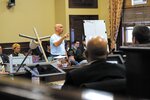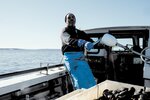After a half-year and counting, a Special Legislative Commission studying decreased quahog catch is nearing the finish line. The commission will discuss their recommendations in an early April …
This item is available in full to subscribers.
We have recently launched a new and improved website. To continue reading, you will need to either log into your subscriber account, or purchase a new subscription.
If you are a current print subscriber, you can set up a free website account by clicking here.
Otherwise, click here to view your options for subscribing.
Please log in to continue |
|


After a half-year and counting, a Special Legislative Commission studying decreased quahog catch is nearing the finish line. The commission will discuss their recommendations in an early April meeting, and will provide a report by May 31st, on whether or not the bay needs to get ‘dirtier’ to save the ailing fishery. While not actually advocating for bad water quality, shellfishermen broadly attribute poor catch to a decline of nitrogen in the bay, which in turn reduces the phytoplankton population that the shellfish feed on.
On Tuesday, Rhode Island shellfishermen, including two members of the Commission, Jody King and Jim Boyd, made their case directly to the commission. The case they made was one of urgency and high stakes. “We’re on the verge of extinction” said quahogger David Ghigliotty. Presenting next to Ghigliotty, quahogger Jim Boyd at times pounded a fist into the table for emphasis: “This has to happen” Boyd said regarding an autumn nitrogen injection, table rattling slightly with each word.
Fewer shellfishermen
How dire is it really for the industry? Three of the presenters pointed to themselves, and their age, as evidence. King, Boyd, and Ghigliotty are all of a generation nearing traditional retirement age. They were the young guns when they began their careers on the water, some 30 years ago, and yet, today, remain not far off from being young guns still. Boyd, in his testimony, backed this up with hard numbers. Currently, 62% of commercial shellfish license holders are 56 or older.
King pointed to his own daily catch targets as further evidence of dire straits. King says that 20 years ago, he aimed to catch between 2,000 and 2,500 littlenecks per day. Today, he aims for 600. This isn’t an issue of too many mouths to feed, either. The number of rakes in the sand has dropped significantly, to a point where only about 40 quahoggers fish full-time, comprising roughly 6% of the total number of license holders. Full timers spend close to 200 days on the water per year. The vast majority of license holders are under 50 days per year. Despite the hours and hours of grueling physical work, King says the new 600 clam target, even if he hits it, isn’t enough revenue to pay the bills. “I used to think I could do this forever” says King. “Now I know I cannot. I’ve had to pick up side hustles.”
What’s the cause?
The question in front of the commission, though, is not whether the industry is in trouble, but more specifically, whether the decline is actually due to nitrogen levels in the bay. Boyd acknowledged other factors that may contribute to changes in marine populations, including waters warming from climate change. However, Boyd and the shellfishermen maintain, with conviction, that the drop in quahogs is above and beyond, corresponding closely to the timeline of plummeting nitrogen levels.
Efforts to denitrify the bay have been part of a broader, and highly successful, effort to improve water quality along the Rhode Island coast. Nitrogen specifically became a focus after a 2003 fish kill in Greenwich Bay, which scientists attributed to hypoxia – a lack of oxygen in the water caused by an overgrowth of phytoplankton. Cut the food source of nitrogen, the thinking went, and the hypoxic events would in turn disappear as well. Shellfishermen, however, say that cutting the food source of the phytoplankton also meant the same for the shellfish. “The shellfish are starving” says Ghigliotty. He and other fishermen say that since the drop in nutrients, they’ve increasingly come across quahogs in poor condition, including quahogs that have little flesh given the size of their shells.
Denitrification was achieved primarily through improvements in wastewater treatment, and a goal was set at the time for a 50% decrease in nitrogen levels. This was achieved in 2012, but levels have continued to drop since then. Boyd presented the Shellfisherman’s Association’s recommendation: to raise winter discharge of nitrogen at the three largest wastewater treatment facilities around the Providence River during the winter. The association says that at the proposed levels of discharge, these measures will not cause summer hypoxia. This is supported by research from URI professor Dr. Candace Oviatt. Oviatt, however, in previous testimony cautioned against these measures as a long-term fix, given broader effects of warming water.
Besides climate change, scientists testifying in front of the commission have brought other explanations as well. In the previous meeting of the body, Dr. Chris Kincaid introduced the possibility that main nitrogen input may flow in from the mouth of the bay rather than from wastewater, and Dr. Jason Grear discussed lab findings showing ocean acidification potentially being a main cause of deteriorating shellfish conditions, including shell integrity and stunted growth.
Why save the quahoggers?
As such, it remains up for debate between scientists, and presumably within the commission, just how much nitrogen injection is a lasting solution to the fishery’s woes. But, even if the link is shown to be strong, given likely and possible benefits of low nitrogen levels, why save the quahoggers?
Part of the answer, of course, was scientific, using data from researchers like Oviatt. The other part, however, was a question of identity and history. That was where presenters Ghigliotty and King made their mark.
King, particularly, wove a long and winding story of his journey through the industry, which at times seemed to tack away from the question of nitrogen. King, an experienced educator and public speaker, came equipped with more props than the average community theater production, including multiple rakes, plastic buckets, rope, and a whole array of poster board displays. At one point, King asked the crowd for the length of the Rhode Island coastline. When, after a long silence, Warwick Representative Joe Solomon Jr. guessed 400 miles, King jokingly admonished him. “You should have known” King said, telling Solomon to look at a quahog necklace in front of him, which King had given to each commission member. Inscribed on the shell was the number 384 – Jody’s answer. King went on to describe the bay as his childhood sandbox, and one of his sources of meaning in adulthood. King at one point listed the governors, mayors, and reporters who have been on his boat over the years.
In times like these, a casual listener would not have been blamed for perceiving it as boastful – “I am really good at what I do for a living” said King. “I am the king of quahogs.” That comment, and a few others about who catches the most or gets paid the most, may have gotten wry half smiles from other fishermen in attendance. That being said, the fishermen were firmly behind the general premise. As Ghigliotty put it, “When we started, quahogging was something you could be proud of.” In King’s case, that kind of thing that was an art; that you could hone and become the best at; that politicians would come to for symbolic meaning. “We’re going to lose something bigger than could possibly be imagined” said Ghigliotty in a passionate closing statement. “It’s a piece of Rhode Island that’s going to go away. It’s a part of our history.”
Representative Solomon Jr., co-chair of the commission, seemed sympathetic to the shellfishermen’s cause in his closing remarks. Solomon described the commission’s work as a “pivotal point,” and he said he wanted to see the industry “back on the upswing.”
Comments
No comments on this item Please log in to comment by clicking here